Bullet throwers
The mechanical centrifugal machine gun impresses with its simplicity of design and promises an unprecedented rate of fire. In such a weapon, the bullets are accelerated and thrown into the target not by the energy of powder gases, but by the centrifugal force created by a madly rotating disk driven by a mechanical engine. The bullets are fed from the axis to the periphery of the disk, accelerated when moving along the radius, they are released there and tangentially fly into the target. With each turn of a disc, one “shot” occurs - more precisely, a throw. Here, in fact, the entire device - no ammo, bolts, complex automation. And from the need for fast rotation of the throwing disk (to give the bullet the desired speed), an enormous rate of fire (as much as the speed of the disk — as many shots) inevitably follows. We also add the relative noiselessness of the “shots”, which ensures the secrecy of shooting.
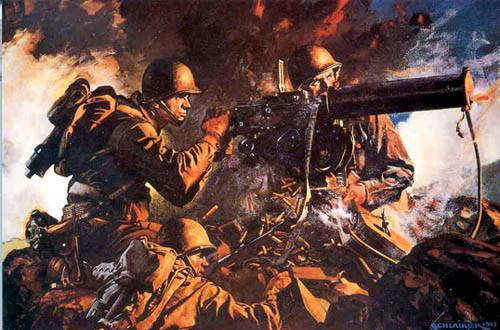
David's weapon
It is already impossible to determine the author of the idea itself. Throwing machines, such as catapults, existed already 2500 years ago. And the sling, through which David laid in place of Goliath, is known from biblical times. But in the early twentieth century, the designers again returned to this idea. In 1908, the Russian engineer Bezobraz developed a draft centrifugal gun. The military cautiously reacted to the artillery system, which did not require gunpowder, and the shells were located on the vertical wheel. During promotion, they broke down and, by inertia, rushed to the goal. Bezobravo’s gun was tested, but they didn’t accept it - the accuracy and accuracy of shooting turned out to be below any criticism.
In 1915, at the height of the First World War, L.V. Kurchevsky, a laboratory assistant at the Shelaputin Moscow Pedagogical Institute, who later became a well-known weapon designer with somewhat scandalous fame, as he preferred exotic technical solutions, developed the principle of “centrifugal sling for throwing grenades”. Her prototype was made by the Dorpomilovsky factory of the firm "Spis and Pren". The sling was a massive machine with a long bar rotating on a horizontal axis. At one end of the barbell was fastened a lock to hold the grenade, at the other - a counterweight in the form of lentils. The rod was rotated from the handle through the Gall chain. The lock was opened by a folding cam mounted on the end of a special lever, the installation angle of which was determined using a notched sector. The descent was made by a cable, pressing the pedal. Kurchevsky considered soundlessness, the use of a manual drive, the range of a grenade to 200 – 210 steps, which was enough for a trench war, as the merits of his device. Tests at the main artillery ground showed the device’s unreliability, but the inventor decided to issue 800 rubles for further work. Later Kurchevsky proposed a more long-range version with a pedal drive. Nevertheless, in January 1916, and he was rejected, because in terms of range, projectile power and accuracy, such weapons were noticeably inferior to the mortars that had appeared in the troops. Yes, and looked like a "bike" in the forward trench, to put it mildly, strange ...
1930-e GG, USSR. Centrifugal machine gun according to the patent of G.M. Gorshkov. Under the action of centrifugal forces, the bullet moves to the rim and is thrown at the target through the exit channel
Soviet centrifuges
One of the first owners of the patent for the "centrifuge" was our compatriot N.M. Pots (1926). The vertical hollow disk was unwound by the engine, bullets were being fed into it along the tubular axis. Under the action of centrifugal forces, they moved along the spiral channel to the rim, where the stopper opened the bullet hole. The bullet hit the exit channel (trunk) and was thrown at the target. To cool the disc, which is heating up during combat work, the inventor came up with a clever system of channels. True, it is not clear why the barrel was needed at all: it is in ordinary small arms that it serves to disperse bullets, and here its role is played by a booster disk.
A year later, engineer I.V. Korotkevich improved the design. He placed the disk horizontally, he also arranged the supply of bullets through his axis, however, he used a canvas “cartridge belt” and a worm feed mechanism for this. Instead of a barrel, a curved chute with a screw thread was mounted on the rim of the disc - unlike the previous design, the ejected bullets rotated in flight, as in a conventional rifled firearm (the centrifugal force pressed the bullets to the bottom of the chute, forcing it to turn along its axis). The propelling disc was driven by a turbine rotated by exhaust gases, compressed air or steam. The system had a doubled rate of fire - two “shots” in one turn of the disk. Horizontal guidance was carried out by turning the body, and vertical - before the start of the drive spin (otherwise the gyroscopic effect interferes).
In the same year 1927 N.P. Chulkov patented an unusually complex device - "Centrifugal machine for throwing projectiles." Only the throwing rotor consisted of more than 70 parts, not counting fasteners. And all this in order to achieve a smooth change in the speed of rotation of the throwing rotor. The shooting was carried out by single shots, while before each shot the throwing rotor was slowed down, “charged” from the feed rotor by a projectile, accelerated, and only after that the shot was made. The weapon has lost simplicity, reliability and rate of fire.
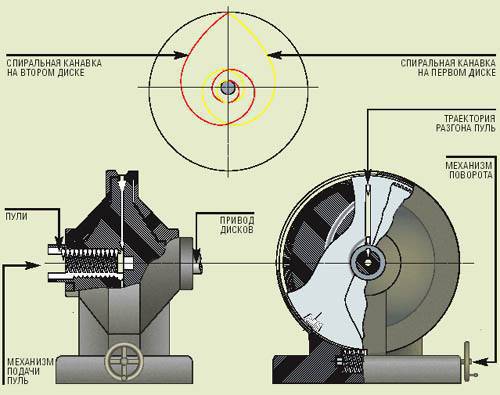
Bullet drops
Abroad, too, did not sleep. The idea of centrifugal weapons was tenacious. In 1920 – 1930's, Americans and Japanese obstinately engaged in such weapons. In the press, a message appeared that the Japanese invented a centrifugal machine gun capable of making 3000 rounds per minute. Those and others suffered a failure: the weapon was massive and ineffective. More messages have been received ...
A fundamentally new, paradoxical kinematic scheme was developed by the inventor Ya.A. Korobov in 1935 year - in it the bullet accelerated in a straight line (!) - along the radius of the disk from its axis to the exit hole in the rim. Throwing discs were two, they rotated on the same axis in mutually opposite directions.
On their internal, facing each other sides there were spiral grooves, twisted also in different directions. Drop-shaped bullets were fed by the mechanism to the center of the disks, from where they fell to the point of intersection of the grooves. As the discs rotated, this point rapidly moved to the rim, dragging the bullet, accelerating it and spinning it at the same time. The principle of operation can be illustrated by the example of scissors: if the blades are separated, an object is placed between them, and then reduced, the object will move progressively from the center of the scissors to their end along with the movement of the intersection point of the blades, although the blades move relative to the object's trajectory in transverse direction. Very clever idea and amazing simplicity of its embodiment!
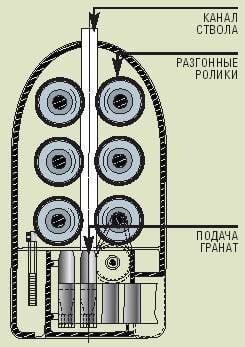 1943, United States. Mechanical grenade launcher S. Brandt. Grenades are successively accelerated by three pairs of accelerating rollers.
1943, United States. Mechanical grenade launcher S. Brandt. Grenades are successively accelerated by three pairs of accelerating rollers.Silent grenade launcher
His version of the centrifugal machine gun in the 1934 year proposed the Englishman B.F.S. Baden-Powell. He equipped it with a multi-compartment shop. The fire was carried out in queues of a given length, which was determined by the number of rounds in the store. Spring feeders threw bullets directly onto the rim of a rapidly rotating throwing disc, without smooth pre-acceleration. The ammunition was dispersed almost instantly, with a “click”, which led to large impact loads and deformation of the bullets upon impact and had a negative effect on the range and accuracy of firing.
American Samuel Brandt of IBM Corporation (New York) in 1943, patented an infantry grenade launcher, in which a fragmentation grenade, like Korobov’s, was dispersed straightforwardly. Along the bore, he installed three pairs of booster rollers, with each succeeding pair spinning faster than the previous one. Ammunition passed as if "on the relay" from one pair of videos to the next, all increasing its speed. A silent line of grenades flew at the enemy.
Rifle spoon
In 1963, American Warren W. Waters proposed a single-shot centrifugal rifle, made on the principle of a catapult. The projectile fit into the spoon-shaped recess of the throwing arm, a powerful spiral spring was cocked, which, straightening, and the metal spherical projectile hit the target. In this case, it was not clear the appointment of a long trunk.
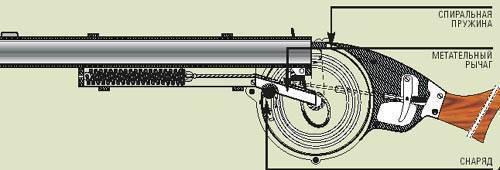
Engineering deadlock
As you can see, engineering thought beat the key. Nevertheless, no “centrifuge” appeared on the battlefield. Why? The principal and irreparable flaws of this weapon prevented. First: the rotational speed of the projectile (more precisely, the speed of its outer rim) must be equal to the initial velocity of the bullet - it is usually higher than the sonic one in 2 – 3. With reasonable disk sizes, it should do around 60 000 revolutions per minute, which is practically unrealistic. (However, the same factor could provide a fantastic rate of fire - the same 60 000 shots per minute - provided that one “shot” is performed in one turn of the disc.) Secondly: it takes quite some time to spin the disc. Consequently, the opening of a sudden shooting is impossible. Third: the aiming of the already “turned on” weapon and the adjustment of firing is impossible - the gyroscopic effect resists any attempts to change the position of the weapon in space. To transfer the "fire" you must first stop the disk, aim at the new goal, and then unleash it again. Fourthly: the decisive disadvantage is that the power of the power plant is much higher than the reasonable power that can actually be applied on the battlefield. The powder charge of a conventional cartridge develops enormous power just for an instant. In centrifugal weapons, the drive must develop the same power constantly. An example of a dead-end engineering solution and gun odds ...
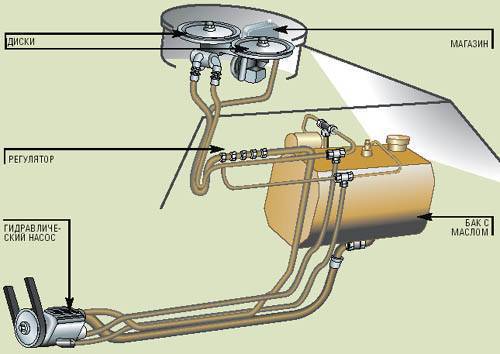
Peace Machine Guns
All attempts to create a centrifugal fighting throwing unit, it seemed, were doomed to failure. For military purposes - yes, but in peace they turned out to be quite effective. For example, this principle is based on the work of simulators for tennis players. After all, a tennis ball or a ping-pong ball does not need to be accelerated to the speed of a bullet, therefore many of the unsolvable technical problems listed above have disappeared by themselves. Such ideal “partners” are equipped with a shop (basket) for several dozen balls and continuously “fire” the athlete ...
However, in our time, "centrifuges" are used not only for peaceful purposes. In the 80 of the last century, the South African company TFM Pty developed a “rubber bullet thrower” for police to disperse demonstrations, gatherings and rallies. On the roof of a police car there are two horizontal discs with grooves on the rims and a bunker with rubber balls. The discs are driven in a counter-rotation from the car's engine. A hundred-gram ball, between the rims of the disks, picks up speed to 80 m / s. His energy is enough to produce the necessary "stopping" action, even at the maximum range - 170 meters. Due to the difference in the speeds of rotation of the discs, the ball twists left or right, and the direction of flight can be changed in the 1800 sector (right-angle to the left and right - due to the Flettner effect) without turning the throwing device itself. The rate of fire is 170 shots per minute.
Centrifugal machine guns, finally, seemingly rejected by the army, began a new life in peacetime - in the police and in sports.

Information